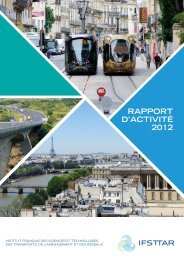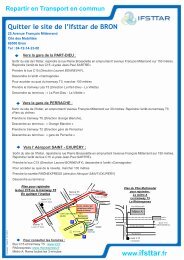french institute of science and technology for transport ... - Ifsttar
french institute of science and technology for transport ... - Ifsttar
french institute of science and technology for transport ... - Ifsttar
You also want an ePaper? Increase the reach of your titles
YUMPU automatically turns print PDFs into web optimized ePapers that Google loves.
esearch orientation r_durability, hazards <strong>and</strong> nuisances<br />
Reducing the seismic vulnerability<br />
<strong>of</strong> existing constructions<br />
Reducing the seismic vulnerability <strong>of</strong> existing<br />
constructions is vitally importantles structures<br />
Columns undergoing<br />
testing at the IFSTTAR<br />
structures laboratory<br />
in Paris.<br />
Reducing the seismic vulnerability <strong>of</strong> existing constructions<br />
is vitally important.<br />
The use <strong>of</strong> bonded composites has become one <strong>of</strong> the<br />
st<strong>and</strong>ard techniques <strong>for</strong> strengthening rein<strong>for</strong>ced concrete<br />
structures, in particular because they have many qualities <strong>and</strong><br />
are simple to use. Carbon fibre based composites provide effective<br />
strengthening, acting as external rein<strong>for</strong>cing bars. However,<br />
we still lack knowledge about the behaviour <strong>of</strong> structures<br />
that have been rein<strong>for</strong>ced in this way when they are subjected<br />
to external stresses (impacts, explosions or earthquakes).<br />
This observation was responsible <strong>for</strong> a major research project<br />
at IFSTTAR (1) which set out to undertake experimental studies<br />
<strong>of</strong> the behaviour <strong>of</strong> rein<strong>for</strong>ced concrete columns that have<br />
been strengthened with bonded composites <strong>and</strong> subjected<br />
to seismic-type stresses. The strengthening materials that are<br />
currently on the market were provided <strong>and</strong> installed by the<br />
project’s industrial partners (Freyssinet International et Cie <strong>and</strong><br />
Vinci Construction France).<br />
To operate with these systems, an innovative anchorage system<br />
was developed <strong>and</strong> validated by experiments at the Autun<br />
Département Laboratoire (CETE de Lyon).<br />
The columns were tested at the IFSTTAR structures laboratory<br />
in Paris. The rein<strong>for</strong>cement was bonded to the test<br />
specimens in a number <strong>of</strong> configurations in order to conduct<br />
a multicriteria evaluation <strong>of</strong> the effects <strong>of</strong> each <strong>of</strong> them. The<br />
per<strong>for</strong>mance <strong>of</strong> the tested rein<strong>for</strong>cement systems was confirmed,<br />
<strong>and</strong> in particular it was demonstrated that the new<br />
anchorage system considerably increases the effectiveness<br />
<strong>of</strong> flexural strengthening.<br />
51<br />
(1) In the framework <strong>of</strong> the ANR-INPERMISE project <strong>and</strong> work on<br />
Raphaëlle Sadone’s doctoral thesis.<br />
@ CONTACT<br />
marc.quiertant@ifsttar.fr<br />
Shear <strong>for</strong>ces in<br />
heterogeneous plates<br />
A new theory<br />
Gaining a detailed underst<strong>and</strong>ing <strong>of</strong> the effect <strong>of</strong> shear<br />
<strong>for</strong>ces in heterogeneous plates poses many difficulties.<br />
Although Reissner’s theory <strong>for</strong> homogeneous plates<br />
dates from 1945, it is still awaiting satisfactory extension to<br />
heterogenous plates. Consequently, when we study stratified<br />
carbon fibre plates we are <strong>for</strong>ced to use more complex models<br />
that are <strong>of</strong> little use to engineers.<br />
By taking up Reissner’s work again, but applying it to a<br />
heterogeneous plate, we have shown that this model is not<br />
able to describe the effects <strong>of</strong> shear <strong>for</strong>ces. In particular, the<br />
inclusion <strong>of</strong> additional variables is required. We have called<br />
the new model the Bending-Gradient model as it makes<br />
use <strong>of</strong> all the components <strong>of</strong> the gradient <strong>of</strong> the bending<br />
moment while the shear <strong>for</strong>ce only considers its divergence.<br />
Mechanical interpretation is nevertheless straight<strong>for</strong>ward.<br />
In the case <strong>of</strong> a homogeneous plate, the bending-gradient<br />
model corresponds simply to Reissner’s original model However,<br />
much better results were obtained when the model was<br />
applied to stratifi ed plates under very general conditions. In<br />
annual report 2011 ifsttar.fr






![Trajectoire le magazine n°3 - Juillet 2012 [.pdf] - Ifsttar](https://img.yumpu.com/30038493/1/190x253/trajectoire-le-magazine-na3-juillet-2012-pdf-ifsttar.jpg?quality=85)

